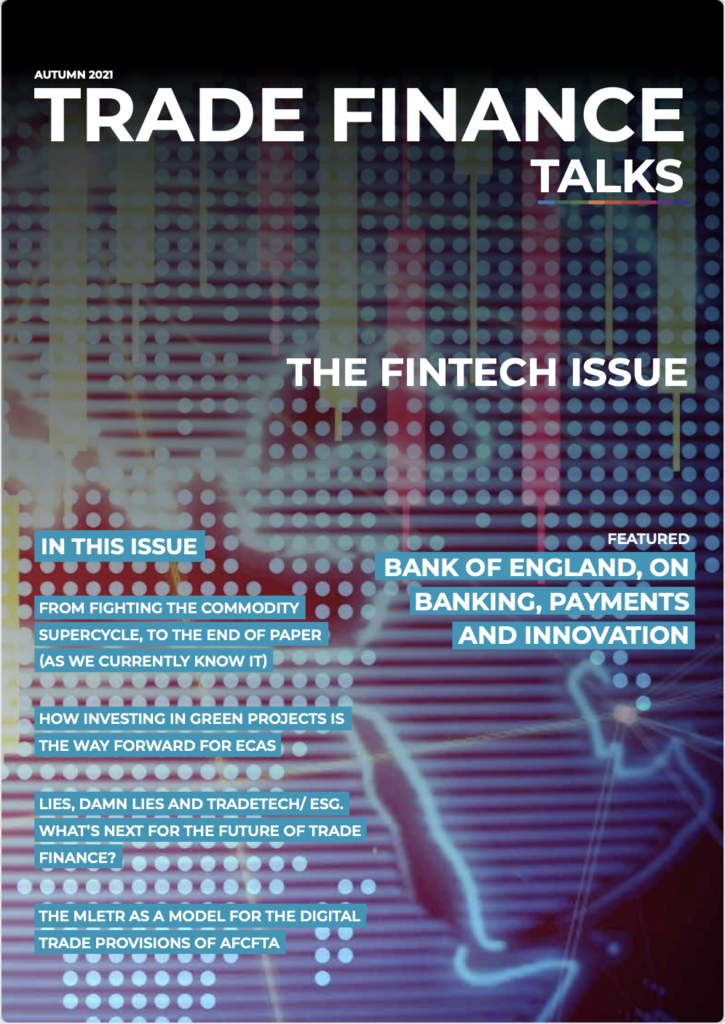Listen to this podcast on Spotify, Apple Podcasts, Podbean, Podtail, ListenNotes, TuneIn, PodChaser
Season 1, Episode 64
Host: Deepesh Patel (DP), Editor, Trade Finance Global
Featuring: Sarah Green, Law Commissioner, Law Commission of England and Wales
If sustainability and blockchain aren’t the biggest buzzwords in trade finance right now, it’s MLETR – the Model Law on Electronic Transferable Records.

In this episode, we discussed the realities of implementing the United Nations Model Law on Electronic Transferable Records into local markets – an incredibly important advancement in accepting electronic signatures. To adopt paper documents electronically, it is necessary to be able to interoperate with different entities, and to do this, a common language – a set of global trade standards – is needed. However, there are workarounds, and we’ve seen an incredible amount of progress, thanks to the English Law Commission and the Digital Negotiable Instruments Act.
From IOUs to trade documents – an overview of a 3000-year-old industry
For internationally traded goods, it’s surprising that for every cargo shipment moving from point A to point B, there’s probably a plane rushing to get there first, to deliver the paper documents with wet-ink signatures, and to allow for the legal transfer of ownership of the goods.
With such an inefficient method for transferring ownership, TFG took a deep dive into why electronic documents are not widely used and accepted, despite their potential to make trade faster and more efficient.

The Law Commission of England and Wales, the legal body responsible for creating the laws that pertain to trade documents, works proactively to ensure that the law is modern, accessible, and fit for purpose. However, there is an inherent lag between the changes in the world of commerce and the adaptation and update of the laws.
Not only did the pandemic exacerbate the need for paper documents to catch up with the changing dynamics of the industry, but also the pressure placed by stakeholders and legal advisers on lawmakers. It would appear that the entire industry was behind this much-needed change. But what has changed?
How the pandemic accelerated trade digitalisation
If there was a way to make international trade easier and more efficient, then why not pursue it? Up until 2020, the use of paper documents and wet-ink signed documents was the norm, and, despite it being inconvenient at times, this did not outweigh the convenience of paper documents.
This is not the first time the industry has tried to shift towards larger incorporation of electronic documents; in fact, this topic has been debated for over a decade. Nevertheless, technology has been met with a significant number of challenges, such as the lack of interoperability and standards, privacy issues, and, most importantly, legal issues. The challenges to the wide use of technology cannot be faced by a single individual, corporation, or regulatory body. It requires a collaborative effort.
The pandemic, despite its myriad of negative repercussions, created the necessary push for change to take place. The conjunction of the limited movement of people with technological developments led to some arguably important changes in legislation concerning electronic documents.
Over the last 18 months, the lack of acceptance of electronic signatures has, therefore, turned into the elephant in the room. With the world being forced to cooperate and collaborate at an unprecedented scale, both to tackle the pandemic and to pursue new applications of technology, electronic documents can now be explored as a viable possibility.

What are the issues with accepting electronic documents under English Law?
The list of issues with paperless trade is long, ranging from the lack of verifiability to the lack of interoperability between companies. Nevertheless, the biggest challenge to the integration of electronic documents, under the current structure of English law, is possession.
The reality, is that there are no real, legal objections under English Law to the acceptance of electronic documents per se, as paradoxical as that may seem. The problem lies with possession, and with the fact that this type of document is regarded as intangible under the law, and an intangible document cannot be possessed.
If a tangible, paper document is transferred from person A to person B, the possession of the document and all the If a tangible, paper document is transferred from person A to person B, the possession of the document and all the rights embodied in that document are easily transferred, tracked, and verified, as only one individual can possess it. With an electronic document, however, doing this becomes more challenging, as up until recently there were no effective methods of achieving this. This is where the role of technology and the incredible progress that has been made over the last few years comes in.
As a result of the shifts in the industry, the market participants’ demand for this type of document paired with As a result of the shifts in the industry, the market participants’ demand for this type of document, paired with breakthroughs in technology that make it possible to replicate the possession aspect of paper documents in an electronic document, the English Law Commission is proposing legislative changes. MLETR, the United Nations Model Law on Electronic Transferable Records, appears to be a phenomenal, over-arching guide that enables each country to implement it in its own way. It was based on the success of this model law that the English Law Commission created its proposal. This proposal revolves around the extension of the concept of possession so that, under the right circumstances, both tangible and intangible trade documents can be used in trade.
How can technology help bridge the gap between the intangible and tangible?
This question is at the heart of the English Law Commission’s consultation paper, which through extensive research aimed to identify the core features of what made not only a trade document tangible or intangible, but any other object, person, or institution that it was applied to. The result of this paper was a list of three specific attributes that determined whether something is tangible or intangible.
The first attribute is independent existence in the world. Can, whatever it is that is being assessed, exist, even if a person exists or not, or if someone lays claim to it or not, or whether a legal system exists or not.
The second attribute is exclusive possession. If person A can transfer the possession of a document, for example, to person B, resulting in person A no longer owning said document, then it does possess exclusive possession.
The last attribute is divestibility. This attribute relates to the previous one, as when something is transferred from person A to be person B, person A no longer has possession of it, meaning they can divest themselves of it willingly.
According to this research, it is only when and if technology can ensure electronic documents meet these three criteria that the full acceptance of all electronic trade documents can take place. When this happens, intangibility will become irrelevant. In fact, distributed ledger technology has already been used, with a large degree of limitations, to this extent. Nevertheless, identifying this set of attributes will, undoubtedly, have a deep impact on the speed of the adoption of this type of document. Technology will have a clearer framework to build upon.

The truth about the current workarounds
Despite stating, throughout this article, that intangible trade documents such as an electronic payment undertaking cannot be utilised under English Law, there appears to be a workaround.
When certain documents can prove to be more efficient or beneficial for corporations, it becomes common for creative workarounds to be found. This is very common in the industry, and it can be a solution.
Nevertheless, problems with the creative workarounds appear when situations go wrong, such as when insolvency occurs. In this case, the difference between a contractual right (obtained through the workarounds) and a proprietary right (obtained through the law) can make a world of a difference to the parties involved. This is one of the primary reasons why industry participants – now more than ever – support the full use of electronic documents when desired.
The roadmap is here
The English Law Commission has a consultation paper in progress until the end of this month – which you can contribute to here. This consultation paper aims to inform the proposal being created by the institution which will then be presented to the government and, potentially, lead to legislative changes. This paper encompasses a large number of trade documents, such as bills of lading, bills of exchange, prom notes, ships delivery orders, warehouse receipts, marine insurance policies, cargo, insurance certificates, and warehouse receipts.

The English Law Commission has created a roadmap to digital trade documents, through the identification of the three attributes that address possession. By addressing possession effectively and concretely, the main challenge has been tackled and resolved. Even though this might be the first step in the United Kingdom, and there are no globally accepted standards, this is an important step in the right direction.
Even though it would, at first sight, appear that the creation of a global set of standards would be the ideal solution to the problems surrounding electronic trade documents, this may not be the case. Each country, and each economic region, possesses its own set of legislations and jurisdictions, making global acceptance more of a utopian concept than a possible reality.
In summary, we may very soon stop referring to digital trade documents as a “nice-to-have”, but rather as a core component of global trade.












































